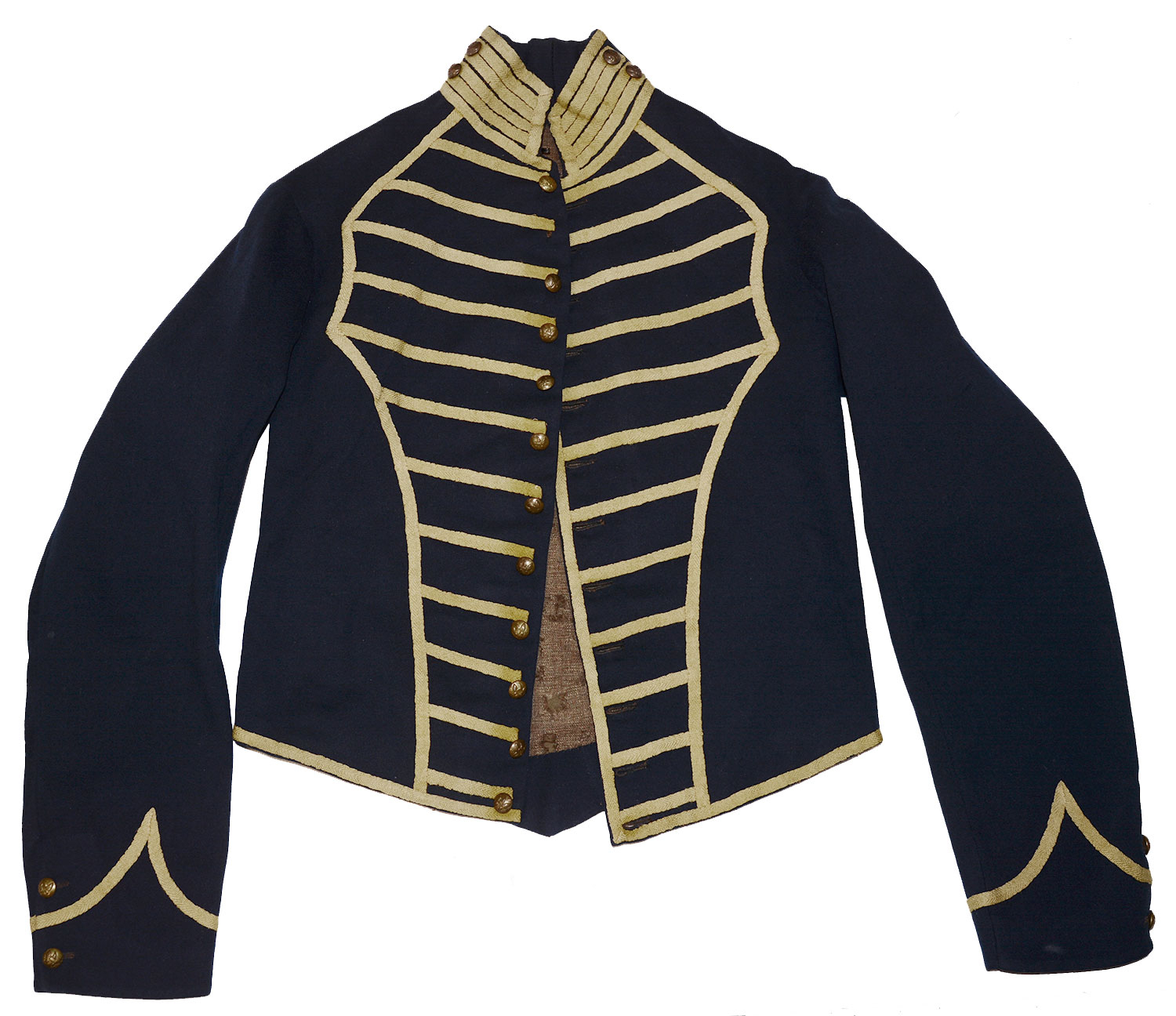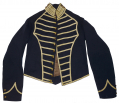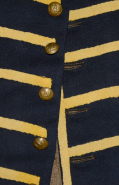site search
online catalog
ID’D P1855 MOUNTED SERVICES MUSICIAN’S SHELL JACKET – WILLIAM OSWALD, 4th PENNSYLVANIA CAVALRY

$8,500.00
Quantity Available: 1
Item Code: 2023-2635
Shipping: Determined by Method & Location of buyer
To Order:
Call 717-334-0347,
Fax 717-334-5016, or E-mail
William Oswald resided in Northampton County, Pennsylvania when he enlisted on August 15th, 1861. On that same day, he mustered into Company “A” of the 4th Pennsylvania Cavalry as a Bugler. Initially, the regiment was organized at Pittsburgh, Harrisburg, and Philadelphia – with the bulk of Company “A” being from Northampton and the vicinity of Allentown. After a brief stay at Camp Curtin, the regiment was sent to the defenses of Washington, D.C., where it served until May of 1862. After a short stint of scouting near Fredericksburg under General McDowell, they joined McClellan’s Peninsula Campaign and saw combat at Mechanicsville, Gaines’ Mill, Glendale and Malvern Hill. After participating in guarding the rear of the US forces as they withdrew toward Yorktown, the 4th fought in almost every major action of the Army of the Potomac until the close of the war. At Antietam, the 4th deployed several companies as skirmishers ahead of the 5th Corps advance across the Middle Bridge. As the cautious movement got underway, a solid shot disemboweled their Colonel and killed another man conversing with him on horseback behind the relative cover of a modest hill.
As the war dragged on, they found themselves on over 100 legendary battlefields of the Eastern Theater including Gettysburg, where they are memorialized by a monument along Cemetery Ridge between the Father Corby and 1st Minnesota Monuments. As Cavalry, they were instrumental in some of the rapid movements of the Mine Run Campaign and during the first days of the Overland Campaign, they participated in raids to the James and North Anna Rivers before seeing action from Yellow Tavern to Cold Harbor. As Lee dug in around Petersburg after the Union’s unsuccessful initial assaults on the city, detachments of the 4th became the escort and headquarters guard of General Warren for a time, and took part in all efforts to sever rail and supply lines into the city. Evidently having seen enough, William decided to muster out at the end of his term of service on August 15th, 1864. The 4th would see action in over 100 battles by war’s end, with William having participated in a majority of the bloodiest ones.
Offered here is his mounted services jacket (Pattern of 1855) with herringbone yellow tape trim in the usual places and the addition of a grid pattern on the front of the body to denote the rank of musician. The jacket is in good condition overall with virtually no exterior damage or undue wear. There is some light fading of the yellow tape across the collar, front, and front cuffs from sun exposure – giving it the subtle look of a veteran piece. The tape is loose in a 1.5” section at the front near the left shoulder, a 1” section on the lower right of the collar, and two .5” sections along the lower front edge at left. Three pinpoint holes are noted in the dark broadcloth of the lower right body of the front. All buttons are present, with the second breast button detached but included. Each button is unmarked on the back and all button holes are machine finished. The black Japanned hook and eye collar closure pieces are complete and secure with minor loss to the black varnish from use. Both pillows are firmly attached at low rear by hand and the rest of the jacket is likewise handsewn.
The lining of the jacket is a lighter brown jean cloth with an understated quilted patterning and light padding across the front of the body. Numerous repairs by hand were made to small areas of wear across the bulk of the lining, but all pieces remain complete and secured to the jacket. The interior left breast pocket is comprised entirely of the same material as the lining with handsewn reinforcements to the edges of the opening and a handsewn hem. The sleeves are lined in a plaid cotton shirting material which extends to the cuffs and they retain all identifying characteristics of the garment including: a Schuylkill Arsenal stamping on the left upper portion near the shoulder reading “SA”, a size marking of “2”, and what looks to be the partial remnants of an inspector marking. The stamp ink used has oxidized to a neat rust color in small areas. The opposite sleeve is also stamped with a “2” size marking, two dots to indicate size, and a handwritten “W. OSWALD CO. A” in thick, inked lettering.
Among surviving Cavalry jackets of the Civil War, this is a true rarity in its identification, rank designation, and condition. This is likely one of the only extant links to William’s service and was undoubtedly present at some of the war’s most iconic happenings. Surely a worthy centerpiece of any discerning collection. [CM][ph:L]
~~~~~~~~~~~~~~~~~~~~~~~~~~~~~~~~~~~
THIS ITEM, AS WITH ALL OTHER ITEMS AVAILABLE ON OUR WEB SITE,
MAY BE PURCHASED THROUGH OUR LAYAWAY PROGRAM.
CLICK HERE FOR OUR POLICIES AND TERMS.
THANK YOU!
Inquire About ID’D P1855 MOUNTED SERVICES MUSICIAN’S SHELL JACKET – WILLIAM OSWALD, 4th PENNSYLVANIA CAVALRY
For inquiries, please email us at [email protected]
Most Popular
Historical Firearms Stolen From The National Civil War Museum In Harrisburg, Pa »
Theft From Gravesite Of Gen. John Reynolds »
Selection Of Unframed Prints By Don Troiani »
Fine Condition Brass Infantry Bugle Insignia »
British Imported, Confederate Used Bayonet »
Scarce New Model 1865 Sharps Still In Percussion Near Factory New »
featured item
SUPERB, RARE MOUNTED SERVICE GREATCOAT
This style of cold weather coat is among those which replaced the long-standing model 1819/32 overcoat in favor of the US model 1851 style, the primary overcoat utilized by US army during civil war. While retaining previous patterns sky blue cloth it… (490-7134). Learn More »
site search
Upcoming Events
May 16 - 18: N-SSA Spring Nationals, Fort Shenandoah, Winchester, VA Learn More »

















